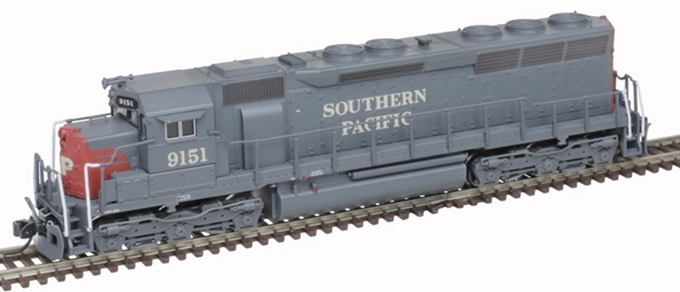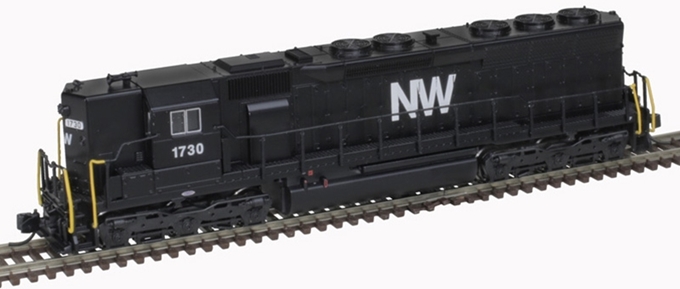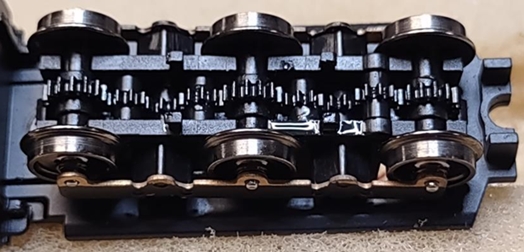



Introduced: 2024
These finely detailed and crisply painted models are available with or without a SoundTraxx Tsunami2 DCC Sound decoder. All versions come with a speaker, so the DCC Ready versions are easily converted to sound. Many of the models come with prototype-specific details. Unfortunately, the Atlas website doesn't go so far as to document what said details might be, so I can't really tell you what they are. About all I know for sure is that the SP versions have SP-style headlights.
Internally, these models are a huge departure for Atlas, looking for all the world like something from the likes of Broadway Limited Imports or Scaletrains.com -

The chassis consists of a metal base with a metal bracket screwed to the top (holding the motor and drivetrain in place). The motor is an open-sided 5-poler with skew-winding. Each motorshaft is equipped with a flywheel. Plastic driveshafts seat inside of the flywheels and connect to notched cups on the truck towers. Short metal shafts connect the cups to the brass worm gears mounted inside the truck towers.
The main PC board is screwed to the top bracket and receives current from the trucks by way of four wires. Separately wired boards fore and aft of the main PC board provide bright white LED lighting for the headlight, rear numberboards and backup light. Additional LEDs are wired up inside the cab, providing illumination for the cab interior, forward number boards and upper headlight (if so equipped). The headlight(s) and backup light are directional whereas the number board lighting is not. Additional wires run from the main PC board to the motor and to a speaker mounted inside the fuel tank. The decoder interface on the main PC board is "Next18" (aka NEM662). Note that F24 controls the cab interior light and F27 controls the number board lights (a fact that the included list of functions does not mention).

All six axles are geared and all gearing (apart from the worms) is plastic. The wheels are blackened and low-profile (no problems on Atlas Code-55 track). There are no traction tires. Accumate automatic couplers seat between the chassis and the shell. The fuel tank is screwed to the bottom of the chassis (and with its screws being, rather inexplicably, hidden away and unreachable underneath the trucks - IE, good luck tightening them if they are loose like the ones on my sample were).

All 12 wheels provide pickup by way of axle-end wipers (the axle ends seat inside of holes in said wipers). Wires soldered to the axle wipers transfer current to the main PC board. The trucks are a rather complex assembly and removing them would likely be a somewhat daunting proposition. An extension on the top of the plastic truck tower assembly holds the trucks inside the chassis, and so I guess you would basically have to completely disassemble the truck towers and disconnect the driveshafts in order to get the trucks off.

As noted above, lighting for the cab interior, number boards and forward headlight is wired up inside the shell. Interestingly enough, the walkway handrail stanchions appear to be glued to the sidesill (a good move IMHO). One interesting (or perhaps odd) feature of these models is the fact that they have two separately applied handrail details on the nose, whereas the handrails on the front and back of the shell are simply molded in (ala previous practice).

These models are at least capable of smooth running, however it may take a few tweaks to get there. Out of the box, mine ran well enough (particularly during its 72 hour speed step 28 break-in period). Unfortunately, stuttering and stalling became an issue once I backed off to more reasonable speeds (speed step 7). And although cleaning the wheels and track certainly helped, I was not able to solve all of the pickup problems until I removed the truck bottom plates and cleaned out the holes in the axle wipers (stick in an Exacto blade and twist). I also took the opportunity to lubricate the axle ends with "conductalube" since they tend to get squeaky if left dry (or at least that's been my experience with other "axle hole pickup" locos).
Once I'd addressed the pickup issues, performance was flawless - smooth, whisper quiet, excellent slow-speed creep and a realistic top-end speed. Pulling power is decent (if unspectacular), with mine able to haul around 38 assorted freight cars through curves on level track (any more than that and the wheels start slipping). I didn't have any problems with the wheels derailing (even on 9.75" radius curves). The sound is nicely beefy, although most people will likely want to turn it down a bit - as delivered, it is LOUD!
One minor annoyance I have with the SoundTraxx decoder is the whole protracted "start up" sequence the locomotive goes through when starting from a dead stop (basically the locomotive sits there making various noises for 4-5 seconds before it starts moving). All very prototypical I'm sure, but not something I really want to have to deal with (particularly when MU'ing with some other type of loco that just wants to go). Changing CV114 from 23 to 39 enables "engine interlock" and eliminates the startup delay.
Prototype information -
During the 1960s the demand for high HP locomotives drove EMD and competitor GE to continue to push the limits of locomotive design. During the time when 3,000 HP 16-cylinder prime movers were the norm, EMD made the decision to introduce a 20-cylinder, 3600 HP design. Introduced in 1965, the SD45, with its distinctive flared radiator design, was purchased by many major US railroads, totaling over 1,200 units until the SD45-2 replaced it in the EMD catalog in 1972. The SD45 did have some teething problems, most notably crankshaft failures. EMD did provide a means to remedy this issue, but some railroads chose to derate the SD45 to 3,000 HP, or in some cases replace the prime mover with the 16-cylinder 3,000 HP as utilized in the SD40-2. Most railroads decided that the extra 600 HP was pushing the limits of the 645 prime mover and preferred the reliability of the 16-cylinder design. The SD40-2 proved to be the best choice for many railroads. It would take a new design, the 710 series prime mover first featured in the SD50, for EMD to reach past 3,000 HP once again. Many units are still in service today, most being rebuilt as mentioned. Some did retain the stock 20-cylinder prime mover, a beefed-up engine block mitigated crankshaft failures. Quite a few examples exist in museums, proving that despite some problems the EMD SD45 remains a popular locomotive.
Features -
- All new tooling
- Golden-white LEDs
- Painted safety rails
- Directional lighting
- Blackened metal wheels
- Magnetic knuckle couplers
- Gold version features Soundtraxx Tsunami Decoder
- Silver "Sound Ready" version is equipped with a speaker and a Next18 DCC socket for easy conversion to DCC sound
Shell Removal -
To remove the shell, start by removing the couplers. Once those are out of the way, you should be able to pull the shell up and off (although it does take a bit of force). And do be mindful of the bendy metal horn and the short wiring harness for the cab interior LEDs.
Grade: B (due to the wiper issues)